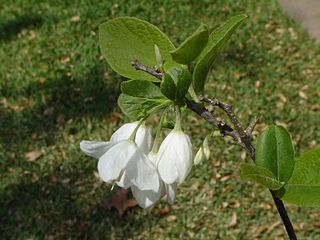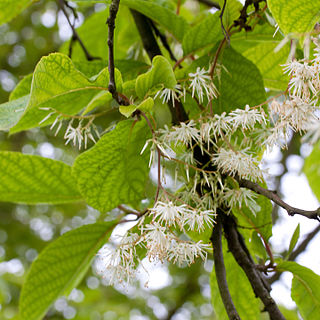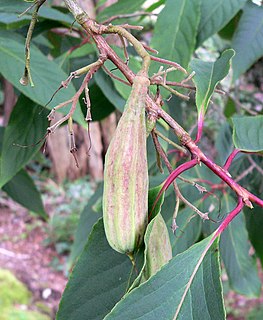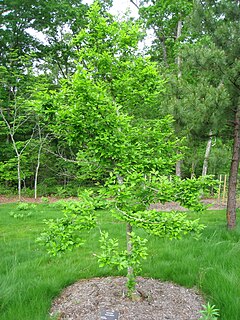
The canyon towhee is a bird of the family Passerellidae.

Eucommia ulmoides is a species of small tree native to China. It belongs to the monotypic family Eucommiaceae. It is considered vulnerable in the wild, but is widely cultivated in China for its bark and is highly valued in herbology such as traditional Chinese medicine.

Pinus armandii, the Armand pine or Chinese white pine, is a species of pine native to China, occurring from southern Shanxi west to southern Gansu and south to Yunnan, with outlying populations in Anhui. It grows at altitudes of 2200–3000 m in Taiwan, and it also extends a short distance into northern Burma. In Chinese it is known as "Mount Hua pine" (华山松).

Nothotsuga is a genus of coniferous trees in the family Pinaceae endemic to China. Nothotsuga contains only one species, Nothotsuga longibracteata, commonly known as the bristlecone hemlock, which is found in southeastern China, in southern Fujian, northern Guangdong, northeast Guangxi, northeast Guizhou, and southwest Hunan.

Styrax is a genus of about 130 species of large shrubs or small trees in the family Styracaceae, mostly native to warm temperate to tropical regions of the Northern Hemisphere, with the majority in eastern and southeastern Asia, but also crossing the equator in South America. The resin obtained from the tree is called benzoin or storax.

Leitneria floridana (corkwood), the sole species in the genus Leitneria, is a deciduous dioecious shrub or small tree, found only in the southern United States states of Arkansas, Florida, Georgia, Missouri and Texas.

Pterostyrax, the epaulette tree, is a small genus of four species of deciduous large shrubs or small trees in the family Styracaceae, native to eastern Asia in China and Japan. They grow 4–12 m (13–39 ft) tall, with alternate, simple ovate leaves 6–17 cm (2–7 in) long and 4–10 cm (2–4 in) broad. The flowers are white, produced in dense panicles 8–25 cm (3–10 in) long. The fruit is an oblong dry drupe, with longitudinal ribs or narrow wings.

Halesia, also known as silverbell or snowdrop tree, is a small genus of four or five species of deciduous large shrubs or small trees in the family Styracaceae.

Halesia diptera, the two-wing silverbell or two-winged snowdrop tree, is a species in the family Styracaceae, native to the southeastern United States from South Carolina and Florida west to eastern Texas. It is cultivated as an ornamental tree.
Annamocarya is a genus of flowering plants in the family Juglandaceae, containing only one species, Annamocarya sinensis, native to southwestern China and northern Vietnam. It is related to the hickories, and was formerly included in the same genus Carya, as Carya sinensis, but also shares a number of characteristics with the walnuts in the genus Juglans. It is grouped with Carya in the subtribe Caryinae. It is sometimes called Chinese hickory or beaked hickory.

Malus sieversii is a wild apple native to the mountains of Central Asia in southern Kazakhstan. It has recently been shown to be the primary ancestor of most cultivars of the domesticated apple. It was first described in 1833 by Carl Friedrich von Ledebour, a German naturalist who saw them growing in the Altai Mountains.

Microsciurus or dwarf squirrels is a genus of squirrels from the tropical regions of Central and South America.

The Korean hare is a species of hare native to the Korean Peninsula and adjoining parts of northeastern China. The Korean hare inhabits diverse habitats within its range, from remote mountain forests to cultivated land. Fur colour varies slightly among individuals, but is generally some shade of liver brown.
Alloxylon brachycarpum is a species of plant in the family Proteaceae. It is found in Indonesia and Papua New Guinea. It is threatened by habitat loss.
Halesia macgregorii is a species of flowering plant in the family Styracaceae. It is endemic to southeastern China, where it grows at moderate altitudes of 700–1,200 m. It is threatened by habitat loss. Recent genetic evidence suggests it is probably more closely related to the genus Rehderodendron than to other species of Halesia; it may be transferred to that genus in the future.

Helicia is a genus of 110 species of trees and shrubs, constituting part of the plant family Proteaceae. They grow naturally in rainforests throughout tropical South and Southeast Asia, including India, Sri Lanka, Indochina, Peninsular Malaysia to New Guinea and as far south as New South Wales.

Pterostyrax psilophyllus is a species of flowering plant in the family Styracaceae. It is endemic to central China. It is threatened by habitat loss.

Rehderodendron macrocarpum is a species of flowering plant in the family Styracaceae, native to southwestern China and northern Vietnam, where it grows at altitudes of 1,000–1,500 m. It is threatened by habitat loss.

Sinojackia is a genus of five to eight species of flowering plants in the family Styracaceae, all endemic to China.

Eucommia is a genus of small trees now native to China, with a fossil record that shows a much wider distribution. The single living species, Eucommia ulmoides, is near threatened in the wild, but is widely cultivated in China for its bark, and is highly valued in herbology such as traditional Chinese medicine.
















